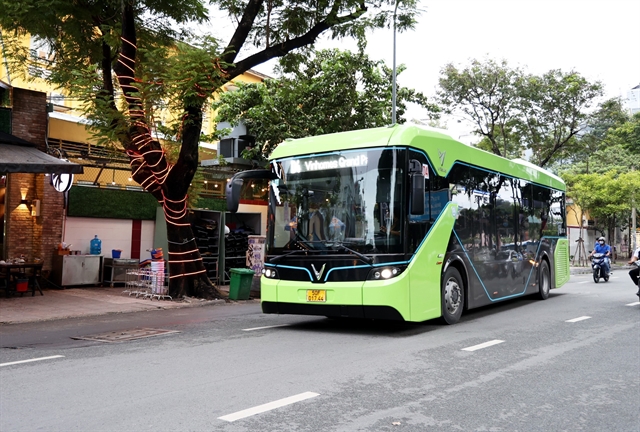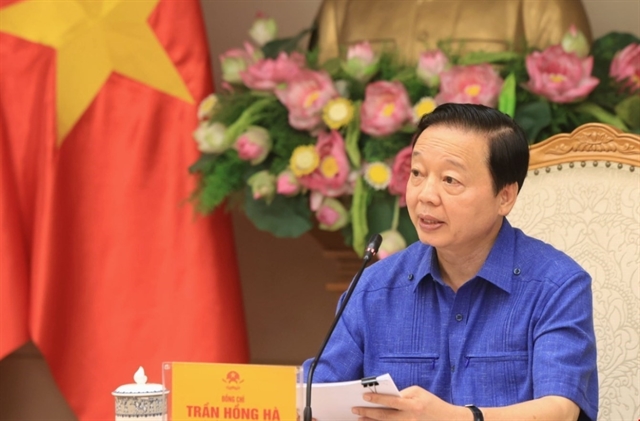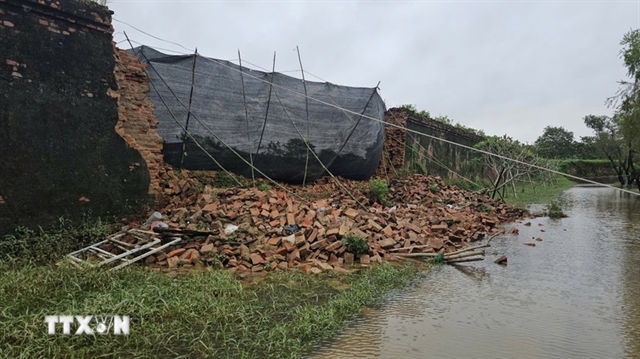 Environment
Environment


|
| Deputy Prime Minister Trần Hồng Hà chairs a meeting to review a draft scheme to strengthen Party leadership in disaster prevention, response on Tuesday in Hà Nội.—VNA/VNS Photo Tuấn Anh |
HÀ NỘI — The natural resources and environment sector was told to ramp up investment in disaster forecasting through fundamental research, the development of large-scale databases, and the deployment of modern monitoring systems, including radar stations, satellites and remote sensing.
Deputy Prime Minister Trần Hồng Hà made the remarks on Tuesday at the Government Office while reviewing a draft scheme to strengthen Party leadership in disaster prevention, response, recovery and the application of science, technology, innovation and digital transformation in disaster management in the new situation.
He also stressed the need to step up international cooperation for data sharing to support accurate forecasting, and to include research on earthquakes and tsunamis.
The sector was required to focus on investment in information infrastructure and equipment to aid local disaster response, particularly in areas vulnerable to isolation, flooding and coastal hazards; creation of professional rescue forces; and mobilisation of private investment in prevention and search-and-rescue activities.
He also said the sector had to enhance and modernise communications capacity to ensure timely, accurate information, thereby raising public awareness and preparedness.
He assigned the Party Committee of the Ministry of Agriculture and Environment to lead and coordinate with other ministries and sectors to swiftly finalise the draft scheme and related documents.
The scheme should set out recommendations for continuing to implement Directive 42-CT/TW of the Party Secretariat on strengthening Party leadership in disaster management, with a particular emphasis on the role of science and technology; prioritising urgent tasks, and rolling out key programmes and projects for 2026–30, alongside institutional reforms to improve disaster prevention and control effectiveness.
Praising the close cooperation between agencies in drafting the scheme, Hà said its goal is to improve prevention, response and recovery in line with the directive.
He said that the scheme is not a legal instrument but a tool for delivering specific tasks in each phase, therefore, it should be implemented through practical projects, avoiding overlap and fragmentation, ensuring a sound evidence base, and fostering close coordination in scientific research and technological application.
He also stressed the importance of examining both internal and external causes of existing problems, particularly institutional factors, to accurately assess disaster management efforts.
The sector should conduct a review of organisational models from central to local level, clear allocation of ministerial and sectoral responsibilities according to disaster severity, and the establishment of operational regulations to ensure effective command, control and scenario planning.
Report
According to the ministry’s Party Committee, the hydro-meteorological sector has modernised forecasting technology, applied artificial intelligence and big data, developed digital early warning maps, and put into operation flash flood, thunderstorm and lightning warning systems.
The national disaster monitoring network currently comprises 215 surface meteorological stations, 27 upper-air stations, 2,599 automatic rain gauges, 426 hydrological stations, 27 marine stations, 19 climate change monitoring stations, 10 weather radars and 177 cameras monitoring dykes and reservoirs.
The legal and policy framework has continued to improve, notably with the passage of the Law on Civil Defence in June 2023, effective from July 1, 2024.
Command and coordination structures from central to grassroots level have been improved, with the National Steering Committee for Natural Disaster Prevention and Control and local command committees assigned clear, dedicated roles, and a 24/7 duty maintained.
Communal-level rapid response forces, comprising 823,000 members, have been established, ready to act under the “four on-the-spot” principle of on-site command, on-site forces, on-site means and on-site logistics.
Forecasting and warning capabilities have improved through science, technology and digital transformation, from AI-based storm, extreme rainfall and saltwater intrusion forecasting, to the Việt Nam Disaster Monitoring System (VNDMS), risk maps, dyke and reservoir surveillance cameras, and flash flood and landslide monitoring devices.
Key research programmes have yielded innovative technological solutions that directly support prevention and response.
Many environmentally-friendly technologies have been expanded, protecting lives while contributing to climate change adaptation.
However, shortcomings remain in implementing the directive, including weakness in direction, communication and policy dissemination; an incomplete and slow-to-update legal and policy framework with notable gaps; significant discrepancies between forecasting and real-world needs; low levels of land and housing support for households requiring urgent relocation; limitations in technology application; and a shortage of highly qualified personnel.— VNS




